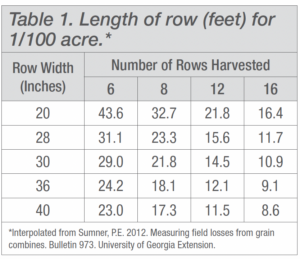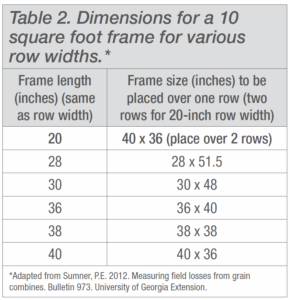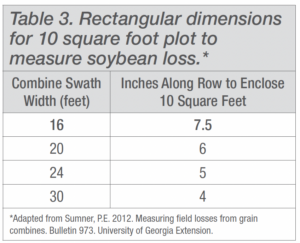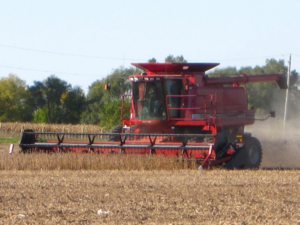- Some mechanical damage is expected at harvest.
- Grain loss behind the combine should be evaluated to determine if a combine requires harvesting adjustments.
- Careful combine operation and adjustment can help reduce harvest loss to an acceptable level.
Corn and soybean seeds that pass through a combine on to the ground represent a loss in potential profit. Harvest losses cannot be eliminated; however, they can be reduced to 1 to 2 bu/acre by adjusting the combine to optimize performance.
CORN: How to Measure Harvest Loss
Determine total ear loss by counting the number of full-size ears or the equivalent in a 1/100-acre area (Table 1). Each full-size ear represents about 1 bu/acre loss.(1)
To measure kernel loss, count the loose kernels on the ground and those attached to threshed cobs in a 10 sq ft area for each row behind the combine. The area should have width equal to the planted row width (Table 2). Two kernels/sq ft equals a 1 bu/acre loss.(1)


Reducing the Potential for Corn Harvest Loss
Proper combine settings can help maximize income by reducing harvest loss and reducing the potential for volunteer corn issues in a following crop. Ear drop, stalk lodging, and kernel loss from threshing and cleaning contribute to mechanical loss. The goals for minimizing mechanical loss are 1% for ear loss, 0.3% for threshing loss, and 0.5% for loose kernel loss.2 A 1.8% mechanical loss from a 150 bu/acre corn yield would be 2.7 bu/acre or an average of 5.4 kernels/sq ft.
Ear loss can be minimized by setting snapping rolls to fit stalk width and running the rollers at the same speed as the ground speed. Cylinder or rotor speed can be adjusted to minimize threshing losses and kernel damage. Loose kernel loss can be affected by fan and shoe settings and combines should be adjusted in fields where stressed plants produced lighter kernels. The settings in manufacturer’s manuals should be followed to help minimize harvest loss.
SOYBEAN: How to Measure Harvest Loss
Soybean harvest loss/sq ft is determined by counting the number of seeds on the ground in a 10 sq ft area (Table 3) and dividing by 10. About four seeds/sq ft equals one bu/acre; therefore, dividing the number of seeds/sq ft by four provides bu/acre loss.3,4 Evaluations should be conducted at several locations to obtain an average loss.

Reducing the Potential for Soybean Harvest Loss
Soybean harvest loss can be as much as 15%.3 Careful maintenance and operation can help keep loss to 3%, which would be 1.35 bu/acre in a 45 bu/acre crop (5.4 seeds/sq ft).4 Most of the loss occurs as shattering at the combine gathering unit between the header and standing soybean plants (Figure 1).(3)
Soybean shattering loss can be reduced by harvesting soon after the seed moisture content reaches 15%.4 Ground speed should be reduced to three miles/hour or less and reels should operate 25% faster than ground speed. The best guide for correct combine settings and adjustments are the manufacturer’s operating manuals.

Figure 1. Most mechanical seed loss or seed shattering occurs at the gathering unit, between the header and standing soybean plants.
Summary
Each harvest season, farmers can help save yield potential through combine adjustments and careful machinery operation. Keeping mechanical loss to a minimum can be optimized by measuring the lost grain behind the combine and making proper adjustments.
